
Yoga For Headaches
Yoga is a natural remedy for people who are prone to migraines and tension headaches. Many yoga asanas can help you get rid of headaches. It does not matter what the cause of your headache is. But yoga to cure headaches can definitely help you. There are specific kinds of yoga asanas for different types of headaches [1].
For example, if you have a cold headache, you might have to try a yoga asana that brings down the phlegm that is accumulated in your head. In case your headaches are due to stress, then you need relaxing yoga poses to cure it [2]. And if you have headaches because you are tired, then the yoga asanas need to give fresh blood circulation to your brain. There is yoga to cure headaches of almost every kind.
Here are some yogas asanas that can cure headaches naturally. Choose the yoga pose that is most relevant to your case.
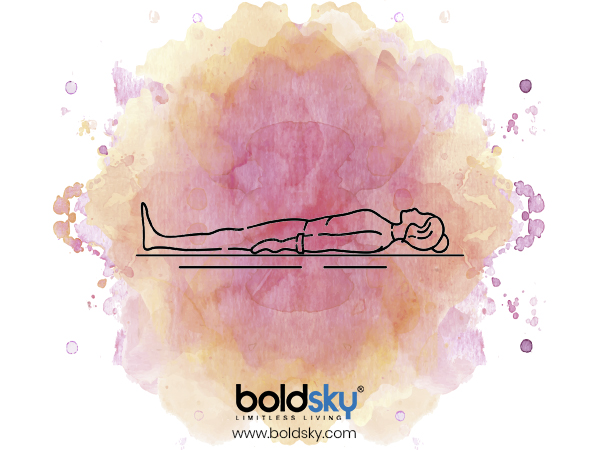
1. Shavasana (Corpse Pose)
Five minutes of Shavasana in the morning and five minutes in the night helps in relaxing the body as well as the mind. This, in turn, helps in preventing a headache. By laying down on the floor, and maintaining a steady breath, the pose helps relax your body and with it, and therefore provide relief from headache pain [3].
How to do Shavasana:
- Use a mat or a sheet to lie on.
- And lie down in the centre of the mat.
- Keep your spine straight and shoulder on your sides.
- Keep your arms wide with your fingers relaxed and palms facing upward.
- Close your eyes and concentrate on your breathing and relax your face.
- Stay in this position for 4-5 minutes.
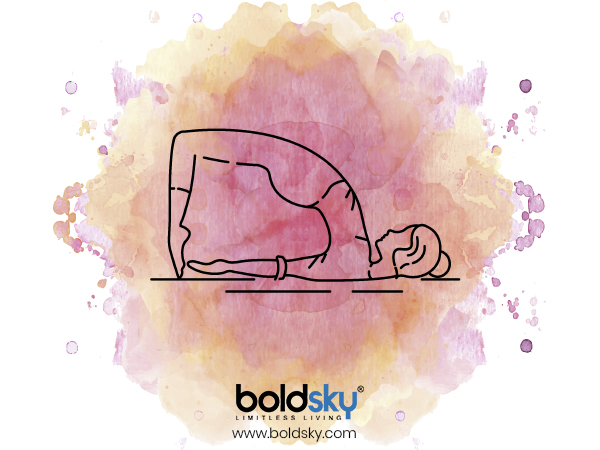
2. Setu Bandhasana (Bridge Pose)
Practising Setu bandhasana involves all of your organs, and regular practise can help tackle headaches [4]. By stretching the muscles in your chest, neck and back, this asana aids in relieving any concentrated pain as well.
How to do Setu Bandhasana
- Lie down flat on your back.
- Bend your knees and keep your feet on the floor apart.
- Your ankles and knees should be in a straight line.
- Keep your palms facing downward and arms resting on your sides.
- Inhale and while doing so, lift your back up and off the floor.
- Roll your shoulders in so that your chin touches your chest.
- Your feet, shoulder and arms should support your weight.
- Interlace your fingers, push your hands to the ground and lift your torso.
- Hold this pose for 1 minute, maintain slow and deep breathing.
- Exhale and lie down on the floor, coming back to the original position.
Caution: Individuals suffering from neck injuries, and back problems must avoid this. Avoid during pregnancy [5].
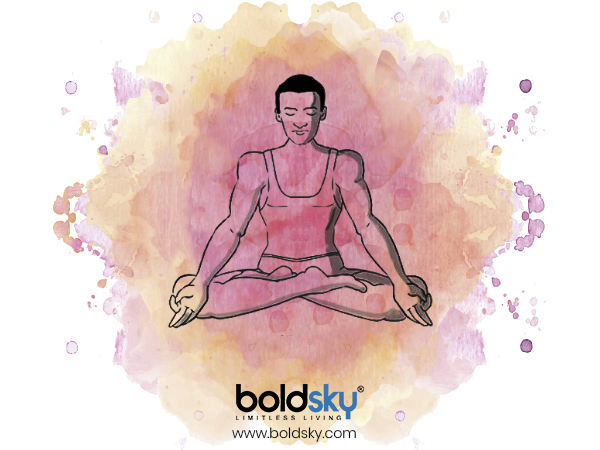
3. Padmasana (Lotus Pose)
Padmasana or the meditative lotus pose is the most fundamental asana in yoga. This pose helps you relax and clear your mind of tensions, providing relief from the headache [6]. Practising the lotus pose is extremely good for those suffering from a migraine.
How to do Padmasana
- Sit on the floor (or in a mat), with your legs straight and stretched out in front of you.
- Gently bend the knees and bring the lower leg into a cradle.
- Using your hands, gently place the leg on the left thigh.
- Now slowly repeat the same with the other leg too.
- Stay in the position for 10 minutes.
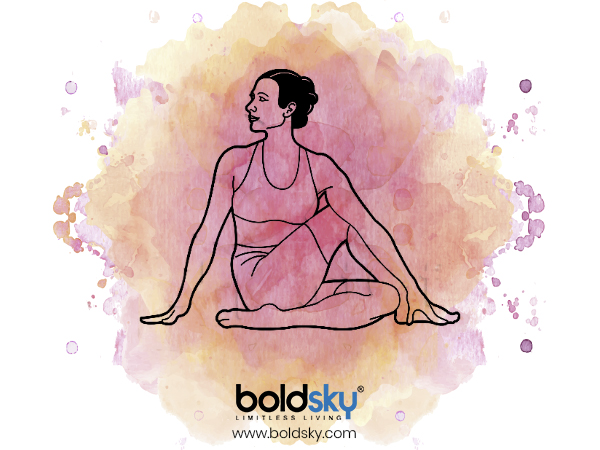
4. Ardha Matsyendrasana (Half Fish Pose)
Practising this pose can help relieve headache because alternative compression helps to circulate blood to various organs of the body, including the brain [7]. Though it is somewhat an advanced yoga pose concerning technique, one can learn it by following its simple steps.
How to do Ardha Matsyendrasana
- Sit on the floor with your legs stretched in front of you.
- Keep your feet together and spine absolutely erect.
- Then, bend your left leg and keep the left heel besides your right hip.
- Get your right leg under your left knee.
- Keep your right hand over your left knee, and your right hand should be behind you.
- Slightly twist your waist, neck and shoulder towards the opposite side, from which side you began the pose.
- Look backwards in the same direction.
- Stay in this position for at least 60 seconds and then exhale.
- Sit straight for a while and then get up.
- Repeat the same with the other foot twisting in the opposite side.
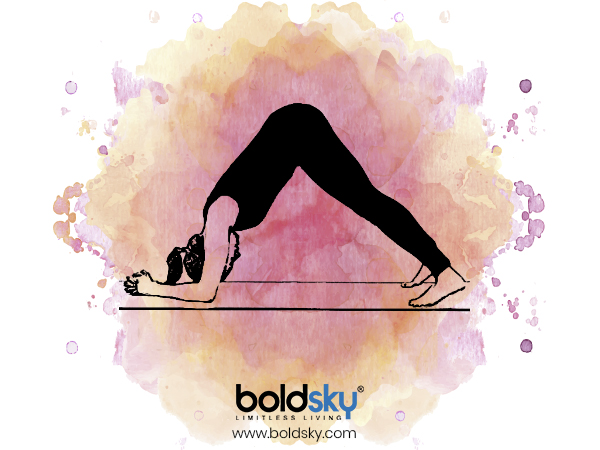
5. Ardha Pincha Mayurasana (Dolphin Pose)
“Ardha” means half, “Pincha” is feathers and “Mayura” means peacock in Sanskrit. Although the translated name of the yoga pose can be confusing, it is due to the posture which resembles a dolphin swimming in the waters. It is a comfortable and relaxed standing pose and is also supposed to be performed on an empty stomach, this pose is somewhat like an inverted ‘V’, with forearms and toes on the floor and the remaining body must form a ‘V’ shape. The dolphin pose also relaxes your body and provides relief from headache [8][9].
 From Banana To Milk, Ginger To Water: Foods That Help Get Rid Of Headaches Quickly
From Banana To Milk, Ginger To Water: Foods That Help Get Rid Of Headaches Quickly
How to do Ardha Pincha Mayurasana
- Get down to your knees and hands as well (like a baby would crawl).
- Now, by placing your forearms on the ground, ensure that your elbows and shoulders are in the same line.
- Making your legs straight, lift your back and hips.
- Shoulder blades should be firm enough and should be into your ribs, and neck should be free, lifting your shoulders away from ears.
- Walk-in towards your arms.
- Inhale and exhale in tune and hold on to this pose for a few seconds.
- Do this 12-15 times.
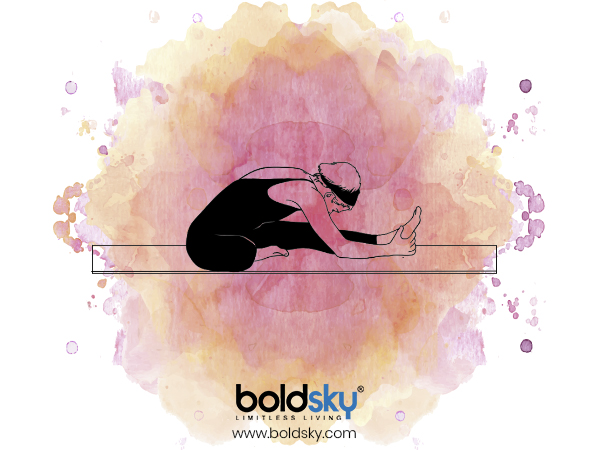
6. Janu Sirasana (Head-to-Knee Forward Bend Pose)
This yoga pose helps relieve anxiety, fatigue, headache and menstrual discomfort [10]. By calming your brain, the head-to-knee forward bend poses also help ease tension headaches.
How to do Janu Sirasana
- Stretch your legs forward, take a deep breath in, get your right heel inwards while bending your right knee and make your right sole touch the inner side of the left thigh.
- While your left hand is resting on the ground beside your buttocks, push your right hand in the right groin and then exhale.
- Maintain this position for a few seconds.
- Now, with your arms outwards, reach to expand your front torso, with the line of your right leg.
- Don’t move your hips, but just your groin in a to-and-fro motion.
- By lengthening forward, make sure you maintain a comfortable stretch.
- First, your lower abdomen will touch your thighs, followed by the upper torso and then comes the head.
- Repeat the same with the other leg as well.
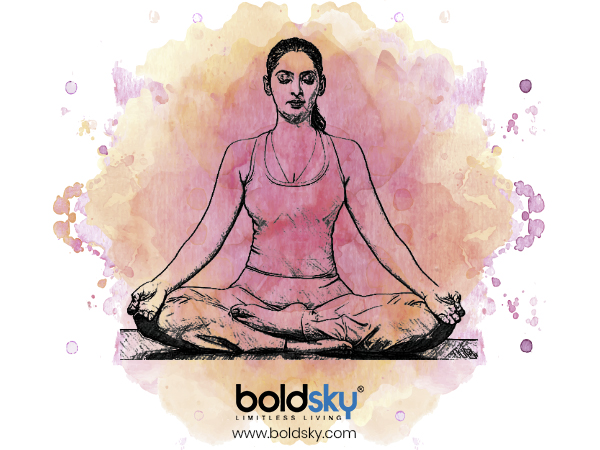
7. Kapalabhati Pranayama
Five minutes of kapalabhati pranayama in the morning helps in relaxing and rejuvenating the mind and keeps away headaches. Also, whenever you feel low in energy, kapalabhati pranayama helps [11].
How to do Kapalbhati Pranayama
- Sit comfortably with your spine erect and take deep breaths.
- As you exhale, pull your stomach and your navel in.
- Keep your right hand on the stomach as you do this breathing.
- Take about 20 such breaths.
- This completes one round of kapalabhati pranayama.
- Once one round is over relax with your eyes closed for a while.
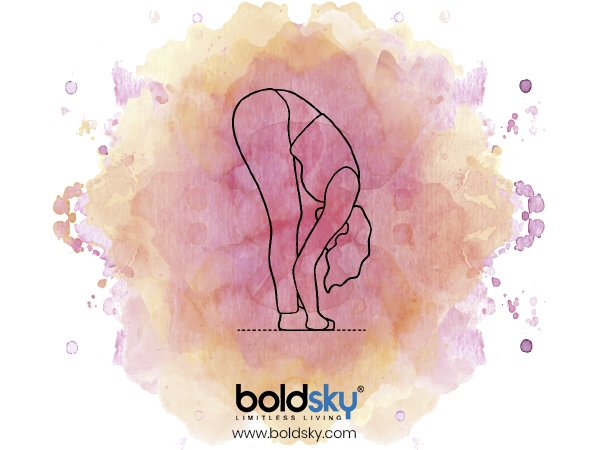
8. Padangusthasana (Big Toe Pose)
‘Pad’ means foot and ‘Angusta’ means toe thumb in Sanskrit. This is one of the basic yoga poses. The best part of this asana is that it helps you to stretch all your muscles from the head from the toe and the utmost thing to be kept in mind for performing this asana is to practice it on an empty stomach and do it in the morning for better results [12].
Note: If you are performing this asana in the evening, make sure your stomach is empty for 6 hours at least.
How to do Padangusthasana
- Stand straight and keep your feet parallel to one another, but 6 inches apart too, and legs should be straight.
- Bend your knees in such a way that your knee caps are lifted outwards.
- Bend forward and aim to touch your forehead to your knees and there should be a collaboration of your head and torso.
- Get hold of your foot toe with the respective side of the hand and hold it firmly. Don’t exert. If you are not able to touch in the first go, be comfortable and keep practising.
- Inhale and exhale in tune and concentrate on your breathing.
- By lifting your torso, keep your elbows straight.
- Do this at least ten times and then straighten your body and hold your toes throughout.
- Relax and get back to your position.
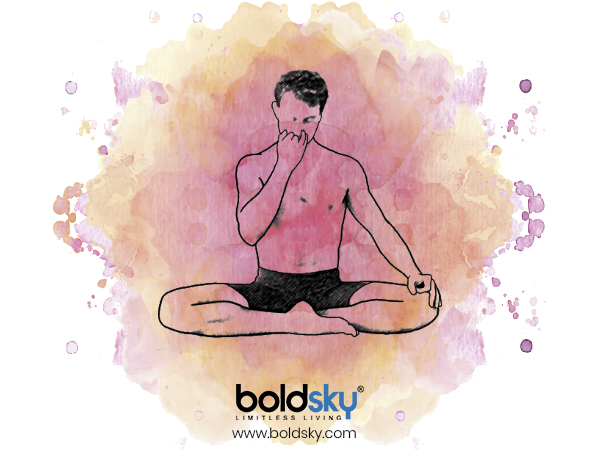
9. Pranayama (Breathing Exercise)
Apart from the specific type of pranayama, that is, Kapalbhati Pranayama, basic forms of this yoga also helps in managing headaches. Pranayama, or breath control, is a central component of yoga and is of different types such as Tribandha and Pranayama, Nadi Shuddhi Pranayama or Anuloma, Ujjayi Pranayama etc. Apart from the Kalpabati version, you can practice the standard breathing techniques to get relief from tension headaches [13].
How to do Pranayama
- Sit on a flat platform with your spine erect.
- Take a steady breath in through both nostrils.
- Inhale until you reach your lung capacity and hold your breath for a second and exhale.
- Then, using the thumb of your dominant hand, block your right nostril and inhale through the left nose only.
- Inhale into your belly, not your chest.
- Once you are full of breath, close your left nostril with the ring finger of the same hand.
- Keep your right nostril closed, and hold the breath for a moment and release.
Or
READ RELATED: Obesity and the Risk of Cancer Linked
- You have to begin this pose by sitting in a comfortable position.
- Keep your hands on your knees, with your palms on the knees.
- Concentrate on your lower belly.
- Now, take a deep breath in through both your nostrils.
- Now, sniff by taking short breaths by contracting your lower belly while pressing it gently with your palms.
- Just begin with 65-70 breaths per minute.
- Gradually, get down till 95-105 cycles of inhaling/exhaling per minute.
- Your two organs should work while performing this asana, that is, your nostrils for inhaling and your mouth for exhaling.
- Repeat it for 15-20 minutes.
 Acupressure For Headache: The Best Pressure Points For Relief And Precautions
Acupressure For Headache: The Best Pressure Points For Relief And Precautions
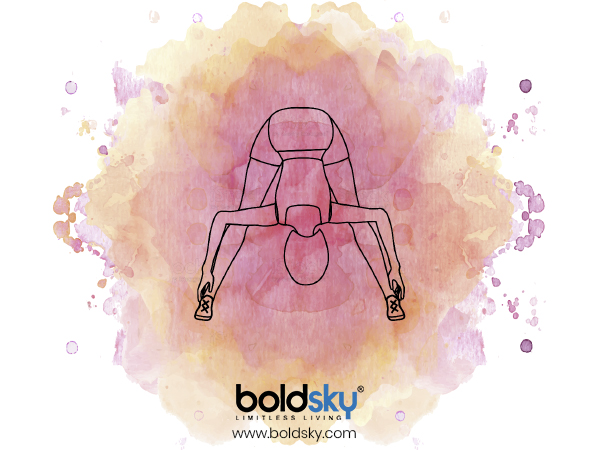
10. Prasarita Padottanasana (Wide-Legged Forward Bend Pose)
“Prasarita” means Wide or stretched out, “Pada” means Foot, “Uttana” means intense stretch and “Asana” means pose. This pose is also supposed to be performed on an empty stomach. The beauty of this pose is, once you are done with it, you will feel healed and relieved of the severe headache [14]. Although it may sound complicated, this yoga pose needs you to stretch your legs wide apart and then bend forward and touch your forehead to the ground. This allows the phlegm stored in your head to be released through your nose [15].
How to do Prasarita Padottanasana
- Stand straight in Tadasana (palm tree pose).
- In Tadasana, you stand straight with both your arms placed upwards and fingers interlocked.
- Begin by taking your right foot a step back in a way that your body looks forward.
- Stretching your hands at the shoulder height, make sure it is above your feet. Then, bring your hands to your hips.
- Lengthen your chest as much as you can towards the sky and stretch your torso to the max, inhaling deeply.
- Now, get your crown to the ground and push your buttocks towards the ceiling.
- Place your hands underneath your legs or on the mat, with your elbows bent, or you can hold your toes with your hands.
- Be in the pose for about a minute and concentrate on your breathing.
- Now, your torso should be parallel to the floor.
- Taking the support of your spine, get your hands to your hips and lift your torso.
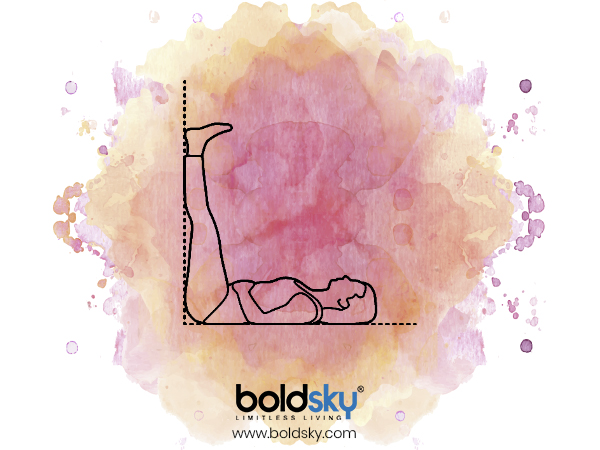
11. Viparita Karani (Legs Up the Wall Pose)
“Viparita” means inverted, and “Karani” means doing, hence, as the name says, you need to perform this pose in an inverted manner. It means legs up and the head down. You have to follow this pose also on an empty stomach, and this is the best pose to treat headache, as it helps to circulate blood to every part of the body. As a beginner, this pose might be tough for you so that you can use a heavy round pillow or a thick blanket as support [16].
How to do Viparita Karani
- Sit close to a wall in your room and spread your legs in front of you and the left side of your body should be touching the wall.
- Inhale and exhale calmly.
- Now lie on your back with the sole of your feet facing upwards.
- Get your buttocks close to the wall, and your back and head should be resting on the wall. Now, your body will be in the 90-degree angle.
- Now, keeping your helping prop, lift your hips and take the support of your hands.
- Keep your body stiff.
- Be in the position for 2-3 minutes and concentrate on your breathing pattern.
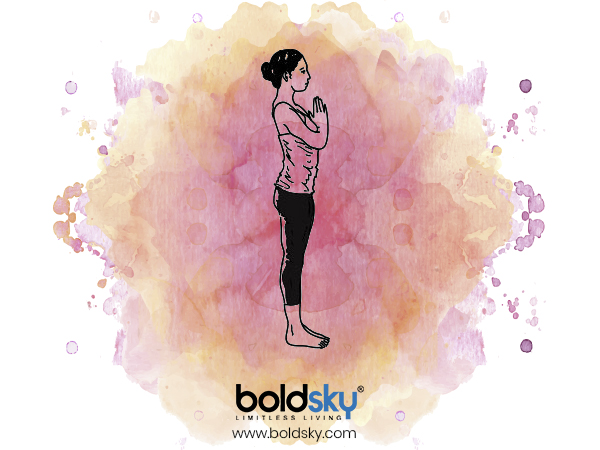
12. Surya Namaskar (Sun Salutation)
Practising this pose helps exercise almost every part of your body. There are twelve different positions in the Surya Namaskar that includes many forward and backward stretches, which can help warm up the body and provide relief from headaches [17].
How to do Surya Namaskar
- Wake up early in the morning.
- Make sure you do not eat anything before doing the sun salutation.
- Choose a place where you can get the sunlight directly.
- Place a mat or sheet on the ground and start doing Surya Namaskar.
- Surya Namaskar comprises twelve distinct body postures.
- The steps are Step 1 (Prayer Pose), Step 2 (Raised Arms pose), Step 3 (Hand to Foot pose), Step 4 (Equestrian pose), Step 5 (Stick pose), Step 6 (Saluting with eight points or parts), Step 7 (Cobra pose), Step 8 (Mountain pose), Step 9 (Equestrian pose), Step 10 (Hand to foot pose), Step 11 (Raised Arms pose) and Step 12, where you exhale and straighten the body, and then bring the arms down.
Note: The ideal time to perform Surya Namaskar is during sunrise while facing towards the sun.
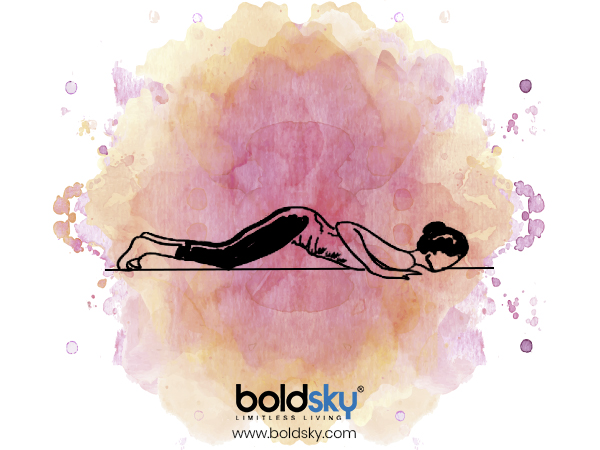
…
Some of the other yoga poses that can help in managing headaches are as follows:
Uttasana (standing forward bend): Most often, a little yanking up can clear your head. We stand in an upright position all day. When you do uttasana, you have to stand straight and bend forward to hold your ankles. Always keep your head away from your knees.
Sirsasana (headstand): Sirsasana or the complete headstand is for people who are prone to migraine headaches. To try this pose, you have to stand upside down on your head. This allows a fresh supply of blood to your tired brain and thus heals headaches [18].
Seated virasana: In this position, you have to sit on your folded knees and bend forward. Place your head on the ground and stretch your arms forward. This pose allows you to relax your mind completely, providing relief from headaches.
Adho mukha svanasana (downward-facing dog): The downward-facing dog position is a pretty versatile asana of yoga to cure a headache in some people. It can help to draw some fresh blood to the brain and also clear your head. This yoga pose can heal almost any kind of headache [19].
Anulom vilom (breathing exercise): This is basically a breathing exercise where you breathe in sharply and release your breath slowly. This opens up your lungs and gives your body a fresh supply of oxygen, relieving you of the headache.
Marjaryasana (cat pose): In the cat pose, you need to be on all fours and then bend your back by pushing out your stomach. Thus gentle massaging of the spine helps to realise tension and stress that cause headaches.
Neck stretching: Cervical spondylitis can also be the cause of excruciating headaches. So doing regular neck stretches can be very helpful to relieve headaches [20].
Meditation: With our busy everyday schedule, it can be impossible to sit at one place and meditate for long. So, make meditation an ongoing part of your daily schedule. As you are travelling or taking a break from your work, you can meditate and keep chanting ‘Om’ in your mind. So this way, the mind is not left empty. This gives positive energy and helps keep off the headache.

On A Final Note…
One of the most important aspects of yoga is that it can be done and is beneficial for all, whether you are young or old or that you are weak or fit. Remember one thing, while performing the yoga poses that can naturally cure headache, don’t force yourself. Just go with the flow. For beginners, it may be difficult for you to perform even basic poses, but don’t feel disheartened.
Source:







